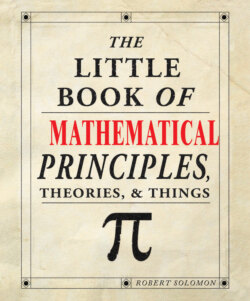Читать книгу The Little Book of Mathematical Principles, Theories & Things - Robert Solomon - Страница 26
На сайте Литреса книга снята с продажи.
3rd century BC Greece The Fifth Postulate Euclid (c. 325–265 BC)
ОглавлениеThe postulate, proposed by Euclid, which gives the properties of parallel lines.
_______________
Euclid’s Elements consists of a chain of theorems each proceeding from the ones before. The starting point of this chain is a set of axioms and postulates, one of which is far from obvious.
Any logical chain of reasoning must start from somewhere, and in the case of Euclid it is a set of common notions and postulates. The common notions apply to all reasoning and are uncontroversial. They contain obvious statements such as the first one which states: Things which are equal to the same thing are equal to each other.
The postulates are specifically about geometry. The first four are deemed unexceptionable, for example the fourth states: …all right angles are equal to each other.
The fifth postulate is much longer and more complicated than the others:
That, if a straight line falling on two straight lines make the interior angles on the same side less than two right angles, the two straight lines, if produced indefinitely, meet on that side on which are the angles less than the two right angles.
In the diagram on the opposite page, XY and PQ are the two straight lines. Another straight line crosses them, and the interior angles on the same side are a and b.
Suppose that the sum of these angles is less than two right angles, that is, a + b < 90° + 90° = 180°. Then, if XY and PQ are extended in both directions, they will meet on the left-side of the diagram.
This is also called the parallel postulate. If XY and PQ are parallel, then they will never meet on either side. Hence a + b must be exactly 180°.
Euclid manages to avoid this postulate until Proposition 29, which proves well-known results about alternate and corresponding angles. He has to use it to prove, for example, that the sum of the angles of a triangle is 180°. The fifth postulate is also necessary to prove Pythagoras’s Theorem and many other standard results of geometry.
There were many attempts to prove the fifth postulate from the other four but these attempts were always shown to contain some other assumption.
It was a long time before people began to suspect that it was impossible to prove the fifth postulate and that there are many possible geometries, some assuming the fifth postulate and some denying it.
See: Non-Euclidean Geometry, page 113–114
